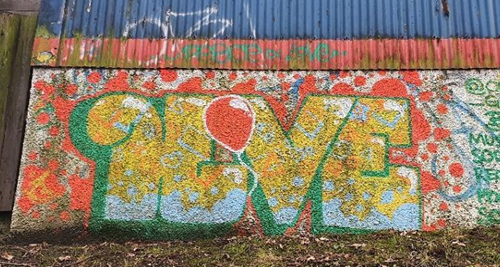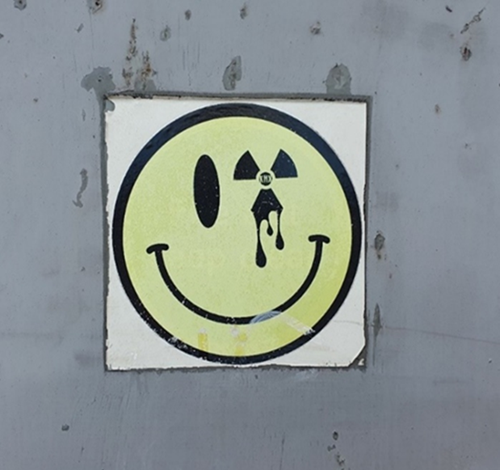'I like it. He looks like a gangster, but he has something nice to say'
Moving beyond the labels - using creative methods with young people to talk about their experiences of safety, harm and place
In this blog post, Janine Ewen describes a creative research project where street art was used to elicit conversations with young people about their experiences of safety and harm in their local community. The method has many resonances with ‘safety mapping’ and at the end of the blog Janine suggests that other practitioners might use the street art featured in this blog in their conversations with young people.
This article describes the use of art, neighbourhood walking and discussions with young people that I developed as part of my creative and experimental research in criminology and sociology in Scotland. 
The study set out to get a better understanding of the lives of young people who congregate, ‘hang around’ or live in a community affected by organised crime in a context of urban inequality and industrial decline – but flipping it around to focus on the positive. One of my key aims was to be able to offer a promising, asset-based lens for practitioners and academics looking to work meaningfully and creatively with young people in relation to safety and criminal exploitation.
Communities impacted by organised crime are commonly portrayed in terms of fragmented relationships, poverty, violence, generally rising levels of crime, substance abuse, and poor health. Obviously, it’s important to stay alert to the local manifestations and realities of criminal harm (Hobbs, 1998) – but it’s not an extra-terrestrial visitor that has suddenly appeared! And these communities are only further victimised and damaged, when constantly the subjects of a deficit narrative depicting all things bad and all grim, a narrative which renders any community assets invisible, as if they do not exist. This is not necessarily helped by a sudden influx of outsider interest after years of inexplicable oppression – not being prioritised, adequately represented or meaningfully included – underpinned by many, many years of prolonged underinvestment. Sudden interest, so late, often exacerbates existing feelings of stigmatisation and marginalisation – all of which further hurts young people’s wellbeing. While we need to understand and appreciate the fuller effects of structural and social decay on young people’s lives, at what point do we move beyond the labels of community ruin?
So, while I intended my research to take account of organised crime and the backdrop of social inequality against which it takes place – I wanted also to offer an alternative to the epithets of poverty and squalor, half-life and deprivation. By walking with young people in their local neighbourhood, responding to street art, the project aimed to offer young people pleasing aesthetics and the possibilities of the imagination, and thus remind young people that they do matter (Billingham and Irwin-Rogers, 2022).
Among other instruments of elicitation, sensory and arts-based methods offer inclusion, education and healing, while also providing a means to express the sorts of feelings and thoughts that traditional research methods often fail to elicit (Malchiodi, 2020; Leavy, 2020). Additionally, when it comes to treating the continuum of trauma, we already know the potential of art to calm the body’s stress response, which in turn helps young people to feel safe (Malchiodi, 2020; Malchiodi, 2023). Contextual safeguarding recognises that children and young people are influenced by environments and people outside their families, and arts-based methods are, I think, particularly useful for understanding and addressing these contexts.
This project was influenced by a paper I read on street life and ‘atmospheres’ (Fraser and Matthews, 2021) that encourages a blended place-based making/understanding of elements of life on the streets, rather than focusing on decontextualised incidents of crime and harm. The street culture analytic provides the opportunity to examine a range of connected social issues: poverty, criminalisation, and expressive street art and graffiti, as well as social inclusion and exclusion more generally (Ilan, 2017; Bloch and Phillips, 2020). Urban sociology in the form of short ethnographic studies, photography, note-taking and walking (‘ethno-mimesis’ and ‘mobile criminology’), supported this step into confronting social pain on the street with creativity (O’Neill et al. 2021; O’Neill and Hubbard, 2010).
My immersion in sensory, arts-based methods, walking and discussion took effect in two main ways. Firstly, while walking through the neighbourhood, I identified and photographed street art and graffiti – the ‘visuals’ of my project. As well as being striking to look at, they crucially provided a connection to several social issues, as well as being directly relevant to the particular urban and community environment in which I was conducting my research.

Secondly, walking and talking with the young people, and subsequent group discussions that I set up with them about the visuals, elicited their views and concerns on topics such as safety, their peers, friendship, life, compassion and creative thinking. Fifteen young people were invited to participate from the support of a grassroots charity that works in areas of disadvantage by offering diversionary activities and sports.
My focus in the remainder of this article is on the second half of the project, in which I share the visuals, creative writing/stories development and responses from the young people.


‘It makes me think of pirates and danger. Pirates use this skull to let people know
they are about to attack, when they are about to be bad. You’re not safe because they are bad. Like Pirates of the Caribbean.’ (Stuart, aged 12)

‘That, you can just, if you love somebody, or a family member, you can always just think of that person when you see this, the people you love very much. Like communication and connection. I’d like more of that in the area.’ (Michael, aged 9)


‘I think the person who drew this was trying to make the area better, more fun. There are lots of spaces here which need to be made better.’ (Elizabeth, 11)
The project’s results show the potential of an asset-focused approach for youth workers, practitioners and academics who want to use creative methods to do meaningful and transformative research and exploration with young people in relation to safety. Inequalities have shaped young people’s experiences of harm and often the focus is on individual young people, as ‘problems’ to solve, rather than looking for solutions within the wider environment around young people.
Professor Carlene Firmin is right. Long term, if we want to increase the safety of children and young people in extra-familial contexts, it’s about making sure that places and communities are safe. It might feel like a win when you’ve put measures in place to keep a young person safe, but that young person will be replaced at once by another, if the community, or place, remains unsafe.
This experimental criminology research has attempted to counteract the labels of community ruin to show what can happen by moving the backstage frontstage (Fraser and Matthews, 2021). By bridging together urban sociology/criminology in the form of short ethnography, photography, note-taking and walking (‘ethno-mimesis’ and ‘mobile criminology’), it allowed us to take a step onto the streets with creativity in mind (O’Neill et al. 2021; O’Neill and Hubbard, 2010).
The central aim was to offer young people the possibilities of the imagination, giving them development and assurances they do matter (Billingham and Irwin-Rogers, 2022).
Although the full project was sensory in nature, this blog has attempted to show the mixture of creative benefits that can come by undertaking such a project.
- Offering an alternative to the epithets of poverty and squalor, half-life and deprivation.
- Strengthening youth participation
- The use of arts-based methods to allow young people to express themselves with additional support from trusted grassroots youth workers
- Creating mini stories from the visuals on the streets to get the creative imagination flowing
- Using the visuals as distinctive prompts to talk about danger, safety, peer support under the right conditions (the toxic smiley, the group of fish, the skull and crossed swords, the heart with the two-piece jigsaw)
About the author
Janine Ewen focuses on criminology/public health and trauma-aware practices. A leading safety and harm reductionist based in Scotland, she specialises in needs-focused policing, public health, harm reduction and developing creative methods for young people. For over 20 years, Janine has worked to improve trauma care and protection for young people who have experienced early childhood adversity and violence, as well as for key populations who are underserved – particularly in relation to protection from organised crime/criminal harm – and often criminalisation. Janine has worked with and advised police and government, arguing for early trauma-aware, harm-reducing and peaceful solutions amidst negative ideologies and criminalisation (Police Scotland, Police Service Northern Ireland (PSNI), Scottish Government).
Janine is now in the process of developing and publishing research and other writing for future students and practitioners in the areas of harm reduction, policing and the use of creative methods for young people who have experienced trauma. She is also interested in knowledge equity and the use of lived-experienced expertise to influence change and generate healing. Janine recently wrote for the Research in Practice Network on exploring the impact of childhood violence through photographs. She is part of the Global Law Enforcement and Public Health Association (GLEPHA).
Janine is happy to offer the pictures featured in this blog post to researchers, youth workers and practitioners who are looking for visual prompts to discuss community safety with young people.
Janine.ewen@gmail.com
Illustrations: Harry Grove (www.harrygrove.com)
References
O'Neill, M. and Hubbard, P., 2010. Walking, sensing, belonging: Ethno-mimesis as performative praxis. Visual Studies, 25(1), pp.46-58.
Billingham, L. and Irwin-Rogers, K., 2022. Social Harm, Mattering and Violence. In Against Youth Violence (pp. 115-149). Bristol University Press.
Hubbard, P., & Lyon, D. (2018). Introduction: Streetlife – the shifting sociologies of the street. The Sociological Review, 66(5), 937-951.
Bloch, S. and Phillips, S.A., 2020. Graffiti, crime, and street culture. In Routledge handbook of street culture (pp. 77-89). Routledge.
Fraser, A. and Matthews, D., 2021. Towards a criminology of atmospheres: Law, affect and the codes of the street. Criminology & Criminal Justice, 21(4), pp.455-471.
Hobbs, D., 1998. Going down the glocal: the local context of organised crime. The Howard Journal of Criminal Justice, 37(4), pp.407-422.
Leavy, P., 2020. Method meets art: Arts-based research practice. Guilford publications.
Ilan, J., 2017. Understanding street culture: Poverty, crime, youth and cool. Bloomsbury Publishing.
Bloch, S. and Phillips, S.A., 2020. Graffiti, crime, and street culture. In Routledge handbook of street culture (pp. 77-89). Routledge.
Malchiodi, C.A., 2020. Trauma and expressive arts therapy: Brain, body, and imagination in the healing process. Guilford Publications.
Malchiodi, C., 2023. Trauma-informed expressive arts therapy. Handbook of expressive arts therapy, pp.142-154.


